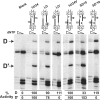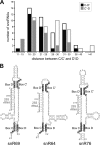The spatial-functional coupling of box C/D and C'/D' RNPs is an evolutionarily conserved feature of the eukaryotic box C/D snoRNP nucleotide modification complex
- PMID: 21041475
- PMCID: PMC3019978
- DOI: 10.1128/MCB.00918-10
The spatial-functional coupling of box C/D and C'/D' RNPs is an evolutionarily conserved feature of the eukaryotic box C/D snoRNP nucleotide modification complex
Abstract
Box C/D ribonucleoprotein particles guide the 2'-O-ribose methylation of target nucleotides in both archaeal and eukaryotic RNAs. These complexes contain two functional centers, assembled around the C/D and C'/D' motifs in the box C/D RNA. The C/D and C'/D' RNPs of the archaeal snoRNA-like RNP (sRNP) are spatially and functionally coupled. Here, we show that similar coupling also occurs in eukaryotic box C/D snoRNPs. The C/D RNP guided 2'-O-methylation when the C'/D' motif was either mutated or ablated. In contrast, the C'/D' RNP was inactive as an independent complex. Additional experiments demonstrated that the internal C'/D' RNP is spatially coupled to the terminal box C/D complex. Pulldown experiments also indicated that all four core proteins are independently recruited to the box C/D and C'/D' motifs. Therefore, the spatial-functional coupling of box C/D and C'/D' RNPs is an evolutionarily conserved feature of both archaeal and eukaryotic box C/D RNP complexes.
Figures







Similar articles
-
Conserved spacing between the box C/D and C'/D' RNPs of the archaeal box C/D sRNP complex is required for efficient 2'-O-methylation of target RNAs.RNA. 2005 Mar;11(3):285-93. doi: 10.1261/rna.7223405. Epub 2005 Jan 20. RNA. 2005. PMID: 15661846 Free PMC article.
-
Efficient RNA 2'-O-methylation requires juxtaposed and symmetrically assembled archaeal box C/D and C'/D' RNPs.EMBO J. 2003 Aug 1;22(15):3930-40. doi: 10.1093/emboj/cdg368. EMBO J. 2003. PMID: 12881427 Free PMC article.
-
Structural features of the guide:target RNA duplex required for archaeal box C/D sRNA-guided nucleotide 2'-O-methylation.RNA. 2007 Jun;13(6):899-911. doi: 10.1261/rna.517307. Epub 2007 Apr 16. RNA. 2007. PMID: 17438123 Free PMC article.
-
The multistructural forms of box C/D ribonucleoprotein particles.RNA. 2018 Dec;24(12):1625-1633. doi: 10.1261/rna.068312.118. Epub 2018 Sep 25. RNA. 2018. PMID: 30254138 Free PMC article. Review.
-
Biogenesis and intranuclear trafficking of human box C/D and H/ACA RNPs.Cold Spring Harb Symp Quant Biol. 2006;71:407-17. doi: 10.1101/sqb.2006.71.025. Cold Spring Harb Symp Quant Biol. 2006. PMID: 17381323 Review.
Cited by
-
Methylation guide RNAs without box C/D motifs.RNA. 2022 Dec;28(12):1597-1605. doi: 10.1261/rna.079379.122. Epub 2022 Sep 20. RNA. 2022. PMID: 36127125 Free PMC article.
-
NOPCHAP1 is a PAQosome cofactor that helps loading NOP58 on RUVBL1/2 during box C/D snoRNP biogenesis.Nucleic Acids Res. 2021 Jan 25;49(2):1094-1113. doi: 10.1093/nar/gkaa1226. Nucleic Acids Res. 2021. PMID: 33367824 Free PMC article.
-
Are Small Nucleolar RNAs "CRISPRable"? A Report on Box C/D Small Nucleolar RNA Editing in Human Cells.Front Pharmacol. 2019 Nov 4;10:1246. doi: 10.3389/fphar.2019.01246. eCollection 2019. Front Pharmacol. 2019. PMID: 31780925 Free PMC article.
-
Advances in the mechanism of small nucleolar RNA and its role in DNA damage response.Mil Med Res. 2024 Aug 8;11(1):53. doi: 10.1186/s40779-024-00553-4. Mil Med Res. 2024. PMID: 39118131 Free PMC article. Review.
-
The Role of Hsp90-R2TP in Macromolecular Complex Assembly and Stabilization.Biomolecules. 2022 Jul 28;12(8):1045. doi: 10.3390/biom12081045. Biomolecules. 2022. PMID: 36008939 Free PMC article. Review.
References
-
- Aittaleb, M., R. Rashid, Q. Chen, J. Almer, C. Daniels, and H. Lee. 2003. Structure and function of archaeal box C/D sRNP core proteins. Nat. Struct. Biol. 10:256-263. - PubMed
-
- Cavaillé, J., M. Nicoloso, and J. P. Bachellerie. 1996. Targeted ribose methylation of RNA in vivo directed by tailored antisense RNA guides. Nature 383:732-735. - PubMed
Publication types
MeSH terms
Substances
Grants and funding
LinkOut - more resources
Full Text Sources
